MARIANI’S
Virtual Gourmet
February
5, 2017
NEWSLETTER
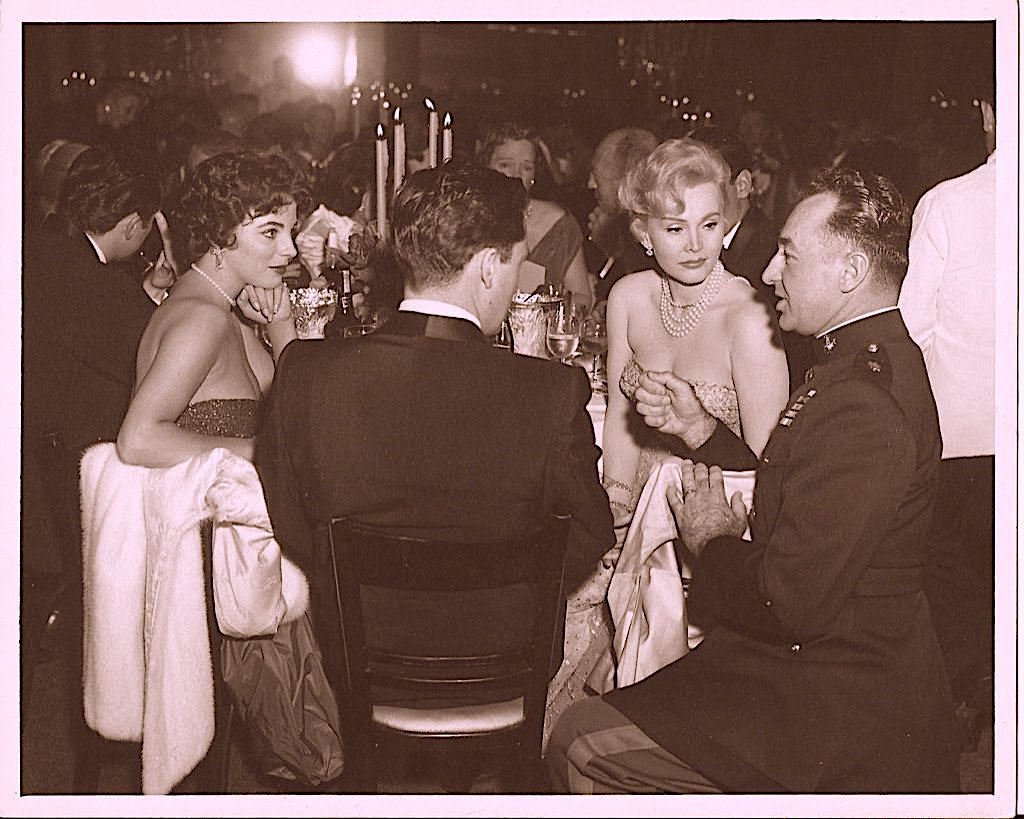
Joan
Collins, Conrad Hilton, Jr., Zsa Zsa Gabor, and friend
at the Hollywood premiere of the film "Heaven Knows,
Mr. Allison" (1957)
IN THIS ISSUE
SO WHAT IF IT'S COLD
OUTSIDE IN SYRACUSE?
By John Mariani
NEW YORK CORNER
CUT BY WOLFGANG PUCK
By John Mariani
NOTES FROM THE WINE CELLAR
BOTTLE OF EHLERS ESTATE'S WINES
By John Mariani
❖❖❖
SO WHAT IF IT'S COLD
OUTSIDE IN SYRACUSE?
By John Mariani

CLINTON SQUARE
As someone who lives in a
winter snow zone (the southern part of New York
State), I share a love-hate relationship with
Mother Nature that by this time in February
tilts towards the latter. So it
is difficult for me 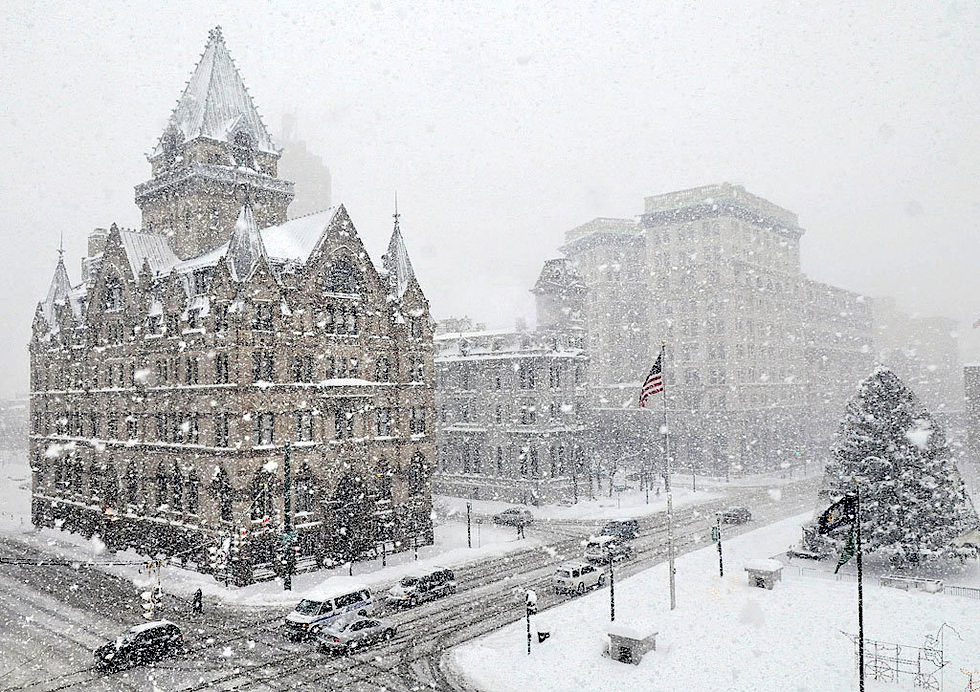 to imagine the
deprivations of far snowier, bitter cold climes
of the northern and western parts of the state,
where snowfalls are measured in feet rather than
inches.
to imagine the
deprivations of far snowier, bitter cold climes
of the northern and western parts of the state,
where snowfalls are measured in feet rather than
inches.
Syracuse is located in the
northeast corner of New York’s Finger Lakes region
and won the Golden Snowball Award for the most
snowfall in the state from 2002 to 2011, with an
average of ten feet per year and the distinction
of being the city in American that gets the
highest annual snowfall. Yet my stalwart friends in
Syracuse simply shrug when I ask them about being
continuously under assault by blizzards,
explaining that, like all cold weather people,
from Kodiak to Kennebunkport, they are so used to
it and plan so well for it, that it’s just part of
their daily lives.
Snow falls, plows come through, you dig out
and get on with your life without whining. That
done within hours of a  snowfall, the natives have come up with myriad things
to do during the winter, whose record temperature
was -26 degrees in 1936.
snowfall, the natives have come up with myriad things
to do during the winter, whose record temperature
was -26 degrees in 1936.
In fact the city has proclaimed
itself the “official home of the
misunderstood season.” Of course, the
Syracuse University basketball and hockey seasons
are in full swing, and Labrador Mountain ski park
is just 30 minutes away, with 22 slopes. Art
museums and galleries are respite from the cold
and warming to the soul.
Many of the Finger Lakes
wineries are open throughout winter for tastings
and tours, at a time when the vineyards are
dormant and winery owners have more time to spend
with visitors.
(For info: http://fingerlakestravelny.com/wineries
)
Since clearing the streets of
snow is a given in Syracuse, a downtown walking
tour is a capital idea—a slow stroll will take
under two hours—not least because the city has
some impressive historic architecture, built on
the wealth created by timber, salt, potash and
nearby crop lands, all easily shipped on the Erie
Canal and a network of railroads. Indeed,
in many ways Syracuse was a true gateway to the
west at a time when it was still pretty wild. Water
is still drawn from Skaneateles 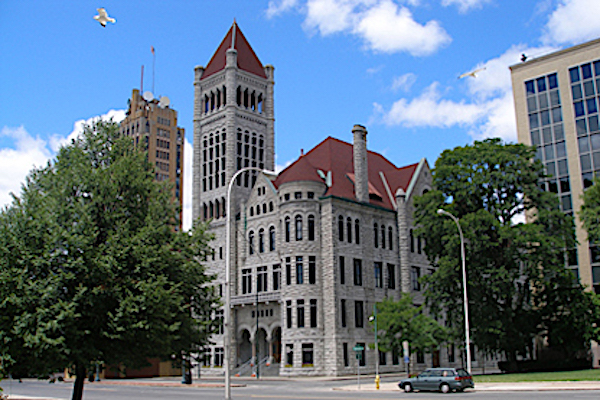 Lake, considered one of the cleanest
in the country.
Lake, considered one of the cleanest
in the country.
Begin your walk in the
wide-open Clinton Square (above), anchored by its 1910
Soldiers & Sailors Monument dedicated to those
who died in the Civil War, surrounded by a
reflecting pool used in winter for ice skating. The Third National Bank
Building, done in a rust-colored Queen
Anne style (on
the left in the photo of Clinton Square),
and the Victorian Gothic-style Syracuse Savings Bank
(in the
middle of the photo of Clinton Square) are
joined by the limestone Gridley Building (on the right),
the Romanesque
City Hall (right), and the newly restored Hotel Syracuse;
once one of the grandest hotels in America, opened
in 1924, it is now a Marriott-managed property.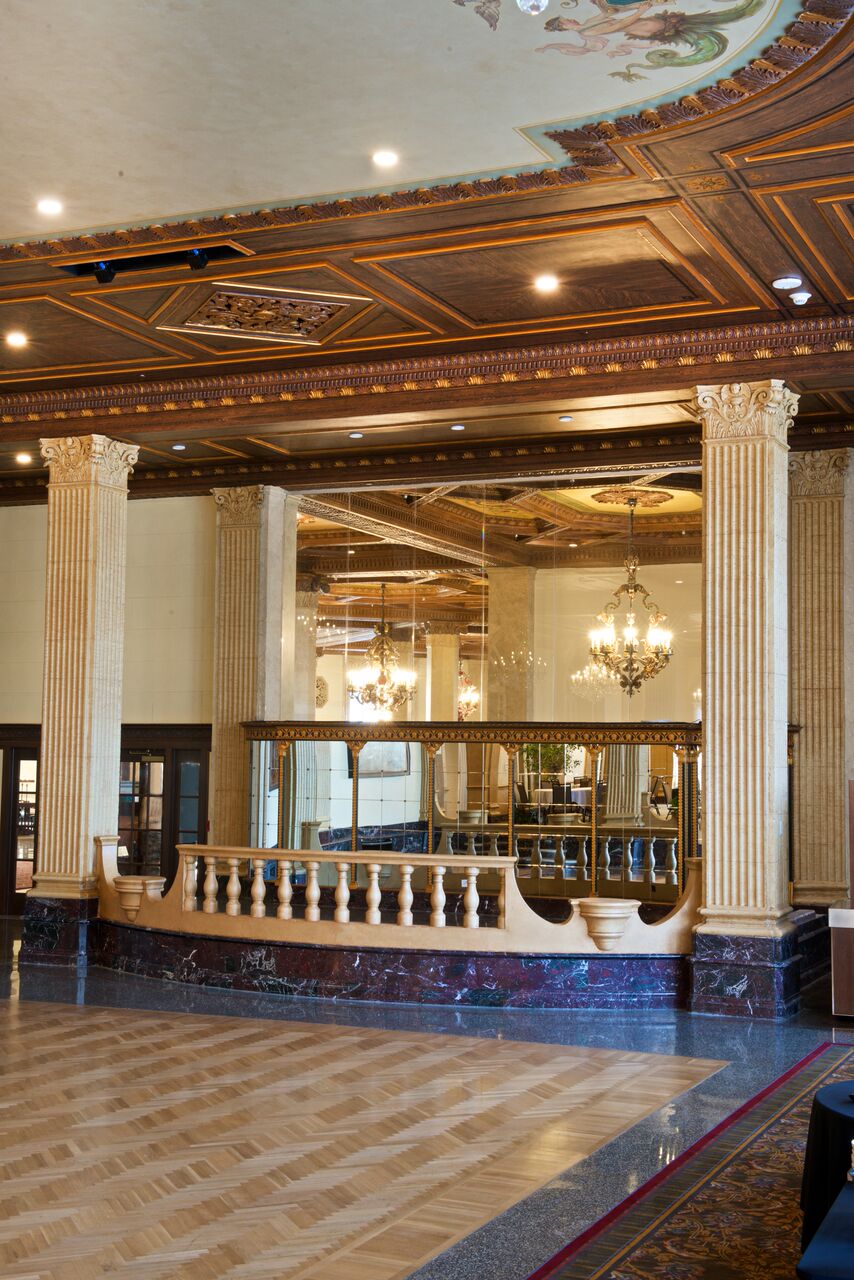
The restoration not only
polished clean the hotel’s magnificent interiors (right), it
unveiled a 40-by-6-foot mural
depicting 20 key events during the first 100 years
of Syracuse’s history, which had been
ignominiously covered over with mirrors in the
1980s. Now
it looks rapturous, showing in vivid colors events
like the discovery of salt springs near Onondaga
Lake, and the formation of the Iroquois
Confederacy.
The Grand Ballroom is once again
magnificent, while all the white-and-gray
bedrooms, now 250, down from 600 (average rate
$300 per night) have been completely modernized
with the most up-to-date amenities.
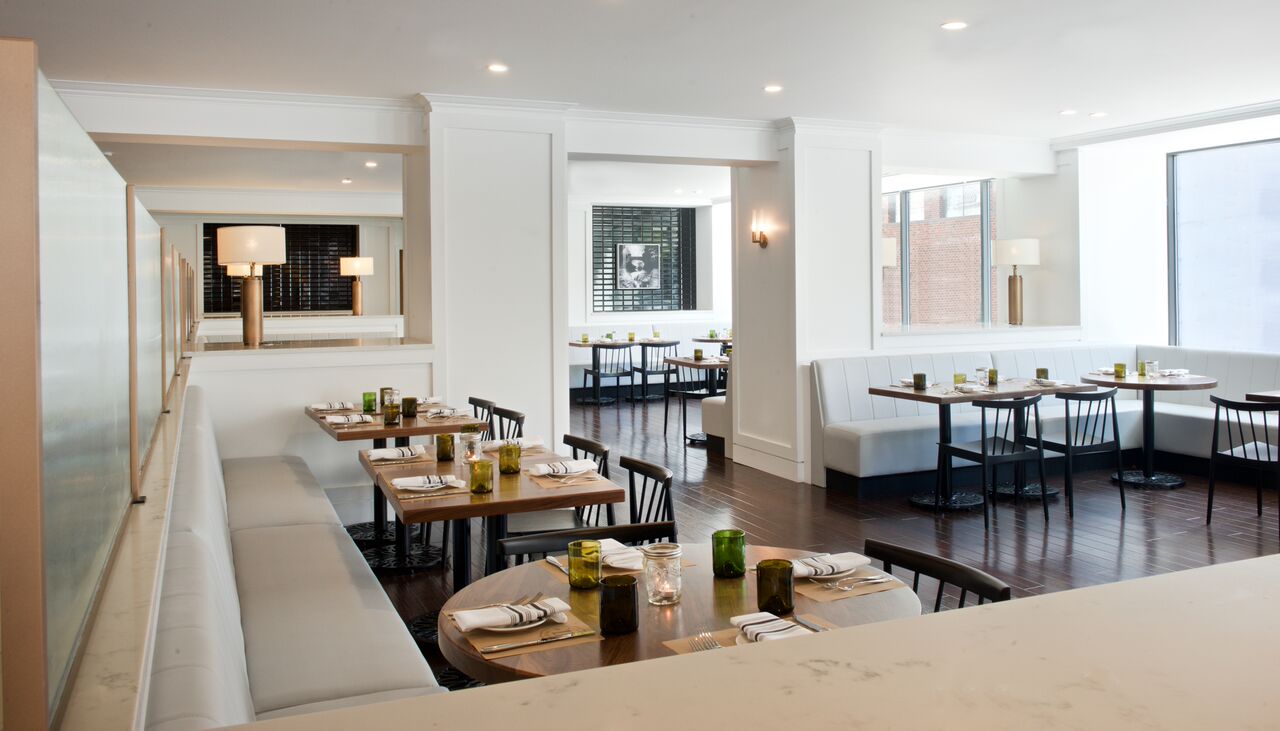 You
can get a palpable sense of the hotel’s history
simply by enjoying a cocktail in the clubbish
Cavalier Room off the lobby, while a more
contemporary look marks the restaurant Eleven Waters
(right),
a sunny American bistro serving everything from an
excellent onion soup gratinée ($7) and the locally
beloved Syracuse salt potatoes ($7) to luscious
merlot wine-braised short ribs with mashed root
vegetables ($19) and a main course of hearty
macaroni and cheese ($14) made with New York
cheddar and Gouda, tomato bacon jam and grilled
chicken. The
spiedie chicken Cobb salad with buttermilk
dressing ($12) is bountiful
You
can get a palpable sense of the hotel’s history
simply by enjoying a cocktail in the clubbish
Cavalier Room off the lobby, while a more
contemporary look marks the restaurant Eleven Waters
(right),
a sunny American bistro serving everything from an
excellent onion soup gratinée ($7) and the locally
beloved Syracuse salt potatoes ($7) to luscious
merlot wine-braised short ribs with mashed root
vegetables ($19) and a main course of hearty
macaroni and cheese ($14) made with New York
cheddar and Gouda, tomato bacon jam and grilled
chicken. The
spiedie chicken Cobb salad with buttermilk
dressing ($12) is bountiful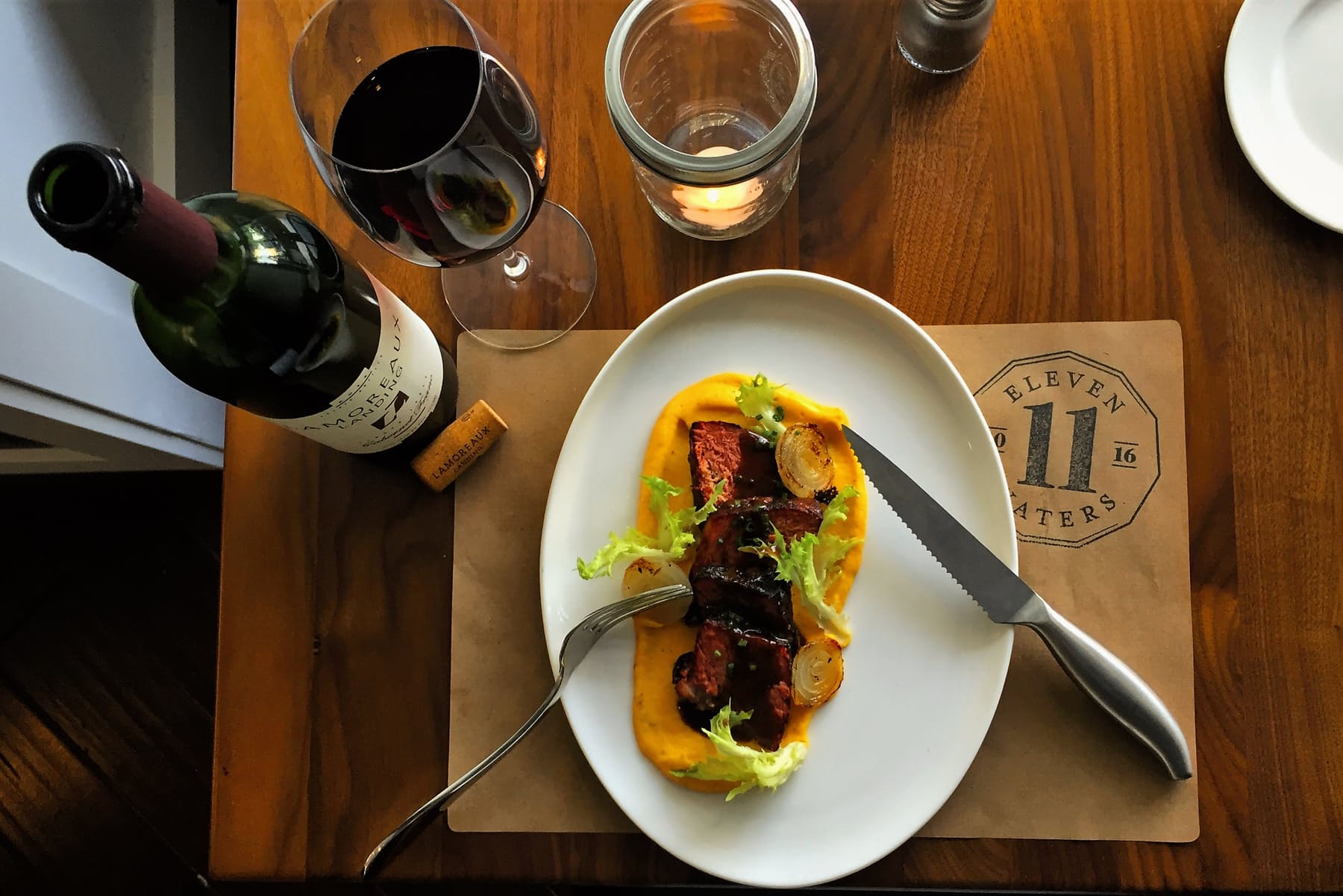 and very good, and all
dishes are listed with suggested New York State
wines by the glass.
and very good, and all
dishes are listed with suggested New York State
wines by the glass.
To appreciate a Syracusan’s
sense of winter, it’s worth quoting the line from
Ralph Waldo Emerson’s poem “The Snow Storm,” of
how “the
housemates sit /Around the radiant fireplace,
enclosed /In a tumultuous privacy of Storm.” Or John
Greenleaf Whittier’s “Snow-Bound: A Winter Idyl” on
the end of the
frigid ordeal:
We felt the stir of hall
and street,
The pulse of
life that round us beat;
The chill
embargo of the snow
Was melted
in the genial glow;
Wide swung
again our ice-locked door,
And all the
world was ours once more!

❖❖❖
By John Mariani
Photos by Mario Diaz
 CUT By
Wolfgang Puck
CUT By
Wolfgang PuckFour Seasons New York Hotel Downtown
99 Warren Street (near Greenwich Street)
646-880-1995
There
is no question that Austrian-born
chef-entrepreneur Wolfgang Puck was one of the
central figures in what was christened “New
California Cuisine” back in the 1980s. Based
in Los Angeles, he first made a splash as chef
at the ultra-trendy celeb haunt Ma Maison,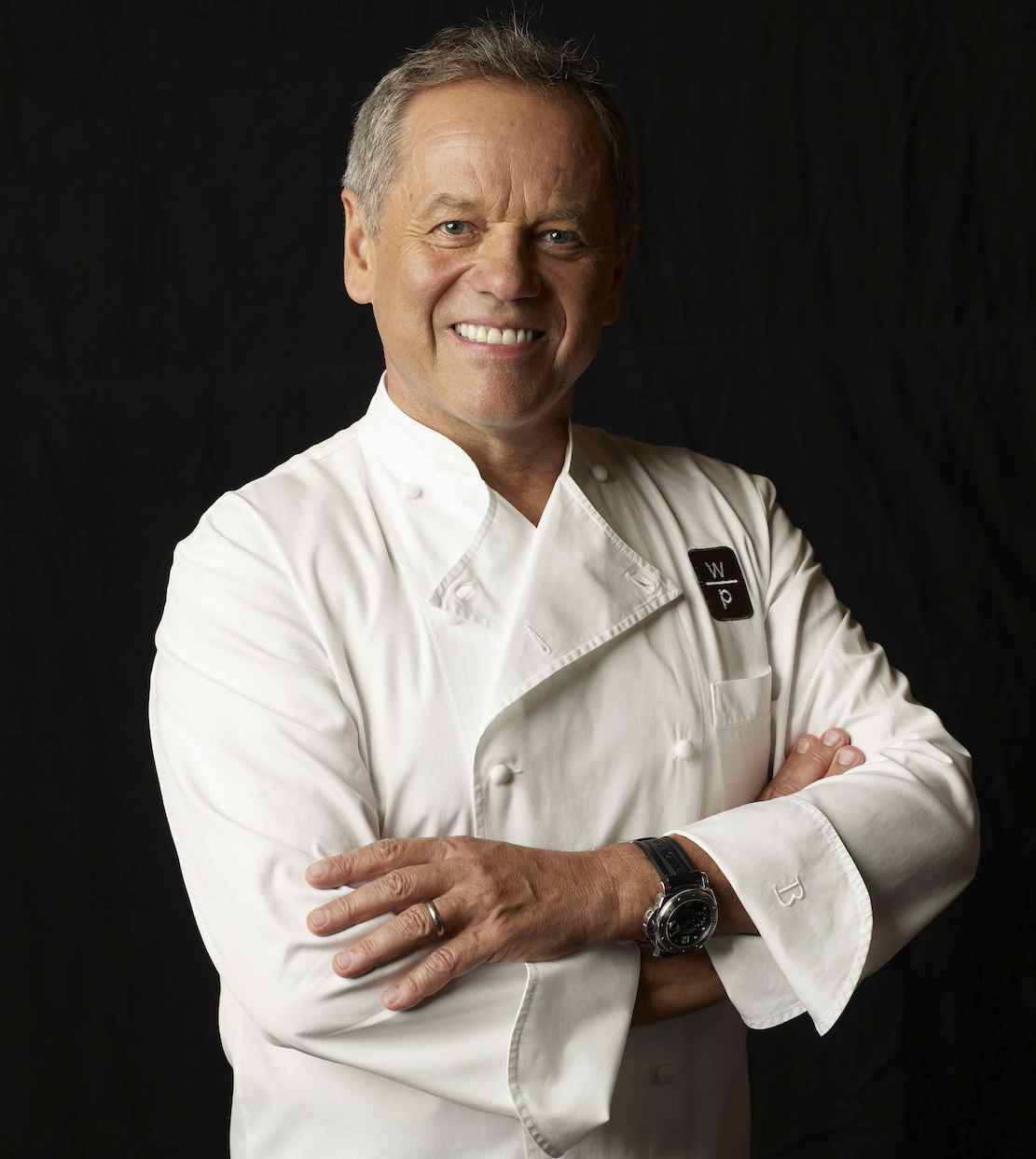 then as
chef-owner of Spago, whose casual chic and
grill-centered cooking was an enormous boost
both to Los Angeles dining and to American
gastronomy.
then as
chef-owner of Spago, whose casual chic and
grill-centered cooking was an enormous boost
both to Los Angeles dining and to American
gastronomy.
Puck also had an impish look
and a Schwarzenegger-style accent that made him
bankable at a time when chefs were emerging as
stars, and he was enormously successful in being
bankrolled to open restaurants, pizza chains,
packaged foods and TV shows under Wolfgang Puck
Worldwide Inc.
But, despite his worldwide ventures, except
for an Express eatery at JFK Airport, Puck has
shied away from NYC, a city known to send celeb
chefs packing after a season.
Photo by Amanda
Marsalis
So, much was expected from CUT
By Wolfgang Puck, a branch of the original
steakhouse in Beverly Hills that won universal
praise, including my own naming CUT the best new
restaurant of the year in Esquire for
2006. The
NYC operation, in the Four Seasons Downtown Hotel,
is the sixth CUT in the chain, including those in
Las Vegas, Singapore and Bahrain, no two looking
alike, and this newest is 180 degrees in
atmosphere from the sunny, spacious original.
The NYC restaurant’s doors open
to a clamorous bar with intensely red neon
lighting to your right--and I have not altered the
photos' color--and a modest-sized 82-seat dining
room on your left (private dining lies beyond). The
room has its windows blocked out; the dominant
color is black, with glaring red accents; the
chairs are a boudoir purple; the curtains shiny
gold; on one wall is written, sounding like a
particularly lame line from Fifty Shades
of Grey: "Sometimes you know it in your
head, the chef whispered. Sometimes you feel it in
your stomach, she smiled, buzzed."
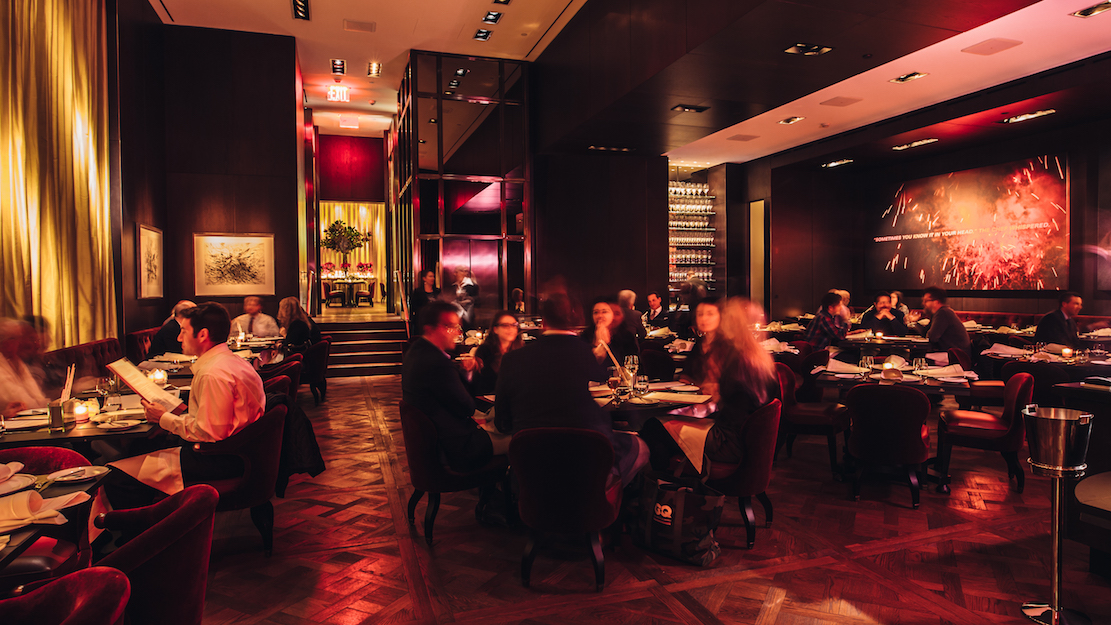 The
service staff, under the very affable
general manager Louis Smeby, is as attentive as
possible, even when the place fills up around eight
o’clock—when ninety percent of the guests seem to
be men who, once they’ve doffed their jackets,
cause the noise level to soar to just shy of
ear-aching, bolstered by piped-in rock music.
Indeed, the whole atmosphere seems intended
somehow to express a NYC power crowd’s self image, but
instead looks a lot more like a posh steakhouse in
a Lake Tahoe casino resort.
The
service staff, under the very affable
general manager Louis Smeby, is as attentive as
possible, even when the place fills up around eight
o’clock—when ninety percent of the guests seem to
be men who, once they’ve doffed their jackets,
cause the noise level to soar to just shy of
ear-aching, bolstered by piped-in rock music.
Indeed, the whole atmosphere seems intended
somehow to express a NYC power crowd’s self image, but
instead looks a lot more like a posh steakhouse in
a Lake Tahoe casino resort.
But you come for the steaks,
and to a list of about 16 different cuts, Puck has
added an admirable swathe of first courses,
salads, side dishes and desserts, pretty much a
Xerox copy of the Beverly Hills restaurant (also
in a Four Seasons hotel).
But first, as at the Morton’s
steakhouse chain, a waiter comes by your table
brandishing outrageously expensive wagyu beef, all
wrapped in white napkins that make these heavily
marbleized cuts look more like Spam than beef. And
since wagyu and Kobe beef, or whatever restaurants
choose to call such cuts, have now become as
widely available as Idaho potatoes on steakhouse
menus, this presentation is a tad twee. A
couple of morsels, served to us as compliments of
the house, tasted very much like the grease that
oozes out of a fatty steak.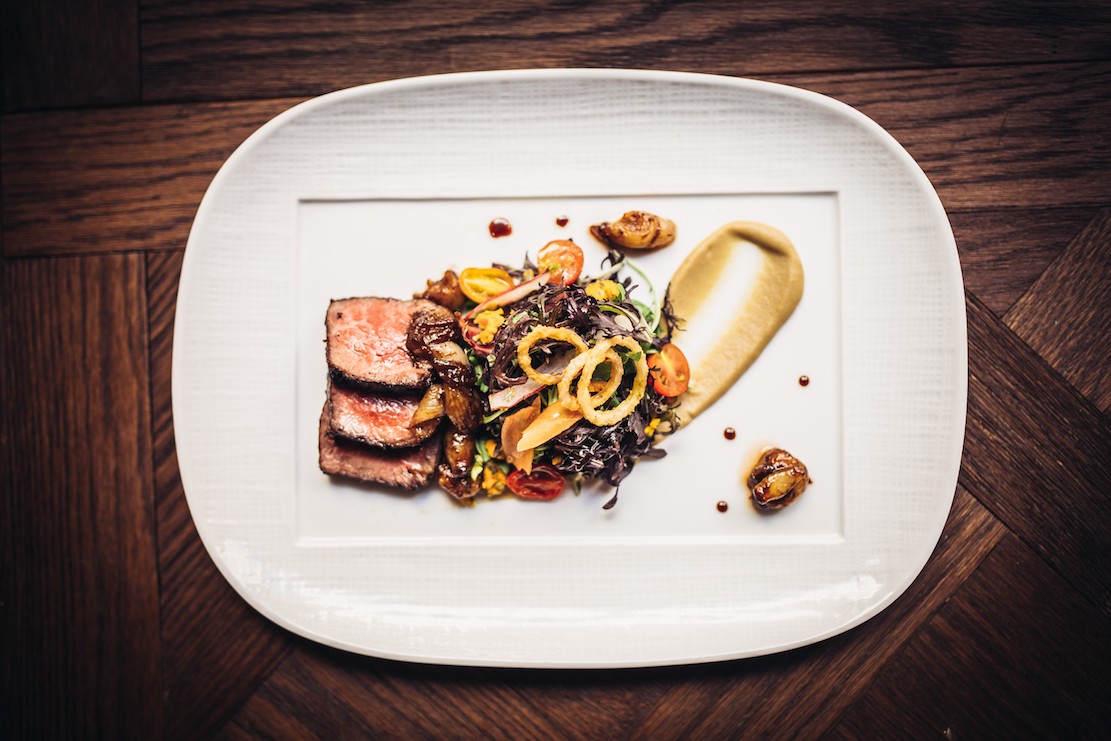
There is
a fine selection of breads and guests receive a
peppery gougère to pop in the mouth. I also
enjoyed both the lustrous tuna tartare ($23) and
beef tartare ($21), beautifully presented in two
tiers of a polished wooden box. A
lobster and blue crab “Louis” cocktail ($24) had a
fair amount of the latter but mostly shreds of the
former in a sticky tomato-horseradish sauce. Thinly
sliced veal tongue ($18) came with artichokes in a
soupy sauce of too-tangy lemon and salsa verde. The
best of the starters was a generous bowl of
delicate tortelloni stuffed with sweet pumpkin and
liberally tossed with sage butter and
Parmigiano-Reggiano ($18), a dish the best Italian
restaurants in town would be proud to serve.
Our
table tried three cuts of meat and one seafood
dish, avoiding the wagyu at $25 per ounce (six
ounce minimum).
The 20-ounce bone-in New York sirloin
($58), aged 28 days, was excellent and impeccably
seared and cooked at 1,200 degrees, the meat with
an assertive beefy flavor. Not so,
though, a mushy bone-in ribeye, also 20 ounces
($59), which had very little beef flavor at all.
It was simply bland. Double lamb chops with a
cilantro-mint raita
yogurt ($58) were of excellent quality, from
Elysian Fields in Pennsylvania.
Most disappointing was a
roasted Dover sole meunière with preserved lemon
and parsley ($58).
While appending the meaningless term
“Dover”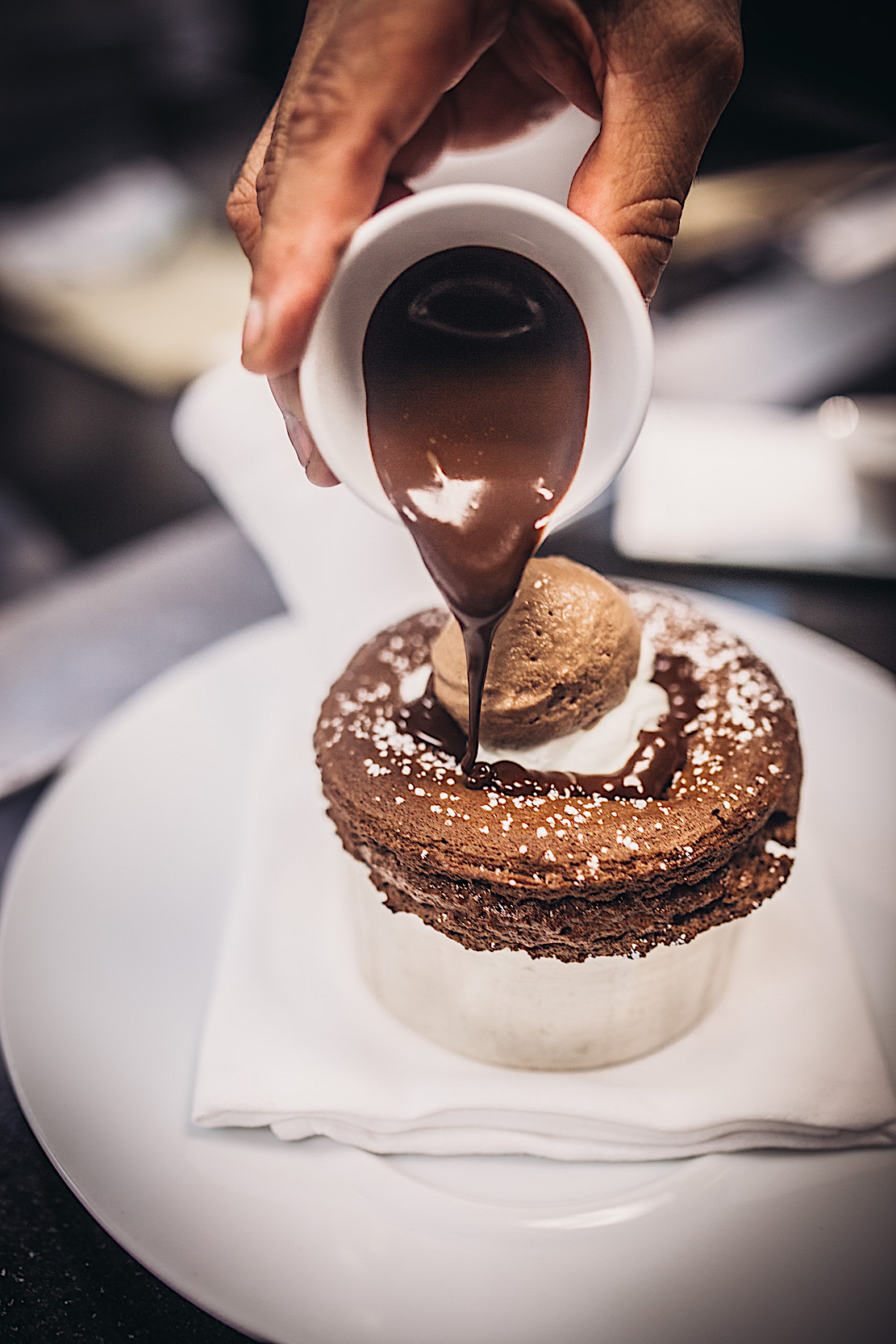 to common sole is
supposed to suggest a nice, fat, thick fish, the
example at CUT would hardly qualify. It was a
small specimen, fairly tasteless and lacked the
extraordinary lavishing of butter that this
classic should have.
to common sole is
supposed to suggest a nice, fat, thick fish, the
example at CUT would hardly qualify. It was a
small specimen, fairly tasteless and lacked the
extraordinary lavishing of butter that this
classic should have.
Pureed Yukon Gold potatoes
($10) and French fries ($10) were good, but
broccoli di rabe ($10) was chewy and needed oil
and garlic. Cavatappi
pasta with “Mac & Cheese” ($14) will win
no points for savory complexity.
Zairah Molina’s sumptuous
desserts show something of the old Puck verve: a
perfect chocolate soufflé with crème fraîche (left),
roasted hazelnuts and gianduja ice
cream
($14) and rich, buttery Seckel pear and almond-oat
crumble with Armagnac date ice cream ($12).
CUT has an excellent, if
high-priced, wine list (not on its the website)
with wines by the glass $12 to $36, and the now
requisite signature cocktails, running a whopping
$18-$25; beers start at $9.
At the
end of a night at CUT you should come away saying,
“I have just had the best steaks ever,” but that
wouldn’t be true.
They are only the most expensive steaks,
and the décor will do nothing to convince you that
this is downtown Daddy Warbucks-Goldman
Sachs-Jamie Dimon NYC. Classy is not a word that leaps to
mind. CUT looks more like a
place where the color commentators at ESPN would
hang out in Bristol, Connecticut.
Open daily for breakfast, lunch and dinner.
❖❖❖
BOTTLE OF EHLERS ESTATE'S WINES
By John Mariani
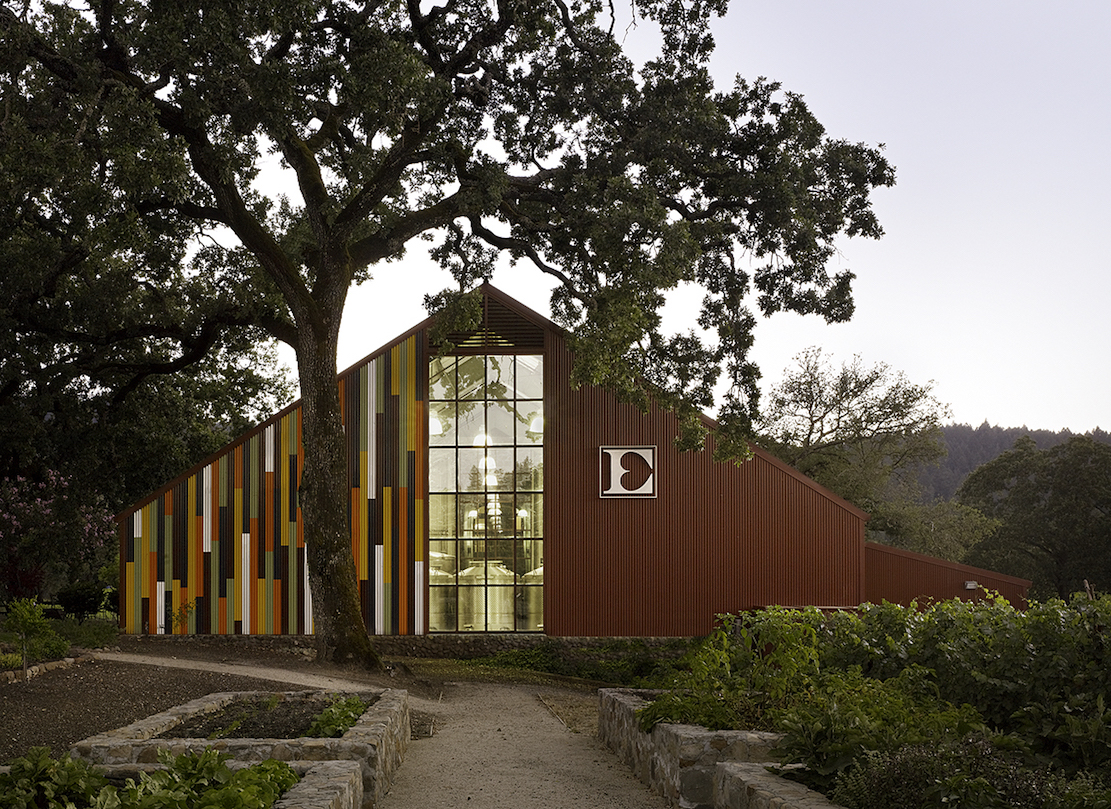
The
alchemy that goes into making a wine in a
personal style can too often be a decision by
committee, creating a wine built to sell to
the widest possible audience. Going
against the grain is not always 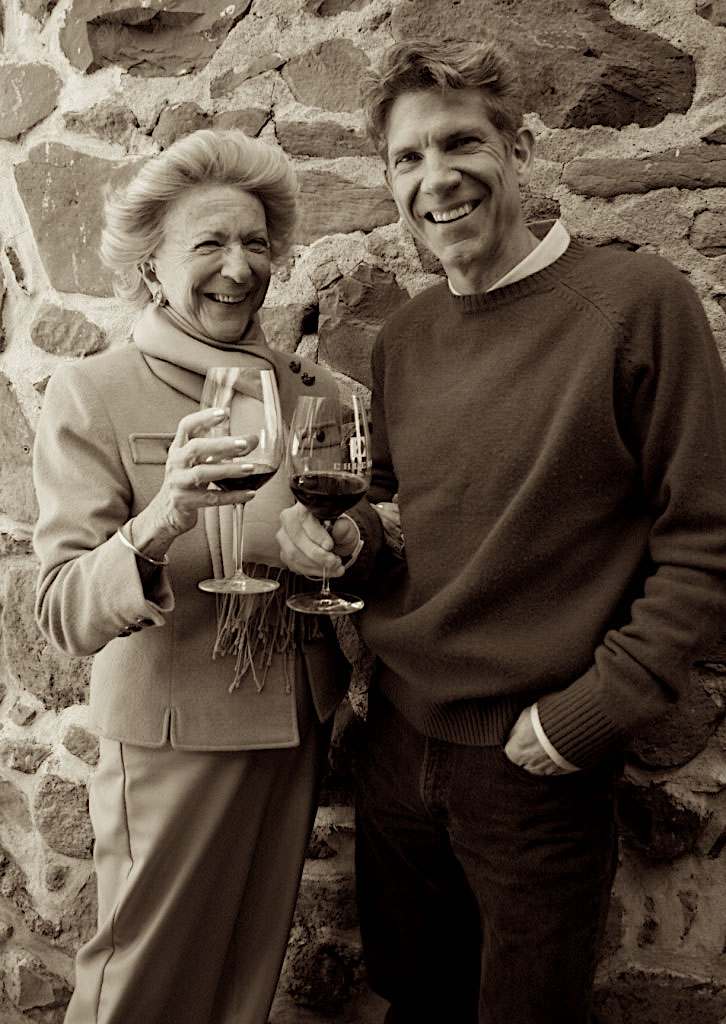 good
business when you’ve got to sell thousands of
cases of sauvignon blanc in a market flooded
with grassy, sweet examples.
good
business when you’ve got to sell thousands of
cases of sauvignon blanc in a market flooded
with grassy, sweet examples.
But that’s the maverick
approach Ehlers Estate winemaker Kevin Morrisey
has taken with sauvignon blanc and other
varietals.
He begins, like most winemakers, by
separating lots, vinifying the grapes, aging
them in oak barrels, and then blending them. But
at this last stage in the annual process,
Morrisey shuts the door to his office and begins
the delicate blending of what will go into the
bottle.
“I spend countless hours
going through endless components,” Morrisey told
me over dinner in New York City. “And all the
time I’m listening to sixties and seventies
rock—Lynyrd Skynyrd, Led Zeppelin, the Stones. I’m
looking for finesse.”
Odd choice of music when
you’re contemplating for finesse, I observed,
but there’s no arguing with the results. Ehlers’
sauvignon blanc is to my mind the finest made in
California, or anywhere else outside of the
Loire Valley.
“I’m looking for what I call
the ‘It’ factor,” he said, “and I have to do it
alone. Symphony
orchestras cannot improvise, like rock musicians
do. A
good doctor has to look at and speak with the
patient, not depend on lab notes for his
diagnosis.
Too often California winemakers are
science geeks. I’ve always asked ‘Why can’t
California sauvignon blancs have the elegance of
good Sancerre?’ and that’s what I aim for in my
wines.”
Morrisey
(right),
who looks like the youngest brother in a family
of Harrison Ford and Willem Dafoe, came to
Ehlers after working for five years at Stags’
Leap as of 1998, then with legendary winemaker
Tony Soter at Etude. Prior to that he’d had a
career in cinematography, worked in France and
married a French-German girl. Only at the age of
35 did he decide to pursue the study of wine at
UC Davis, following up with an apprenticeship at
France’s illustrious Château Pétrus. In
2005 he returned to Stags’ Leap as head
winemaker.
“I had the best job in the
world at Stags’ Leap,” he said. “They pretty
much left me alone, but the corporate structure
was always changing—they had five CEOs in thee
years.” (Stags’
Leap, established in 1893, is now owned by the
huge corporation Treasury Estates of Australia.) “When
I got the call from Ehlers, I was very
indecisive, until a friend of mine said, ‘Kevin,
they’re handing
you a winery.’ I tasted all their wines and
found them to be a revelation, clearly showing
the individual terroir. I also liked that their
estate was 100% organic and farmed using
Biodynamic™ practices.” Morrisey took over as
winemaker at Ehlers in 2009.
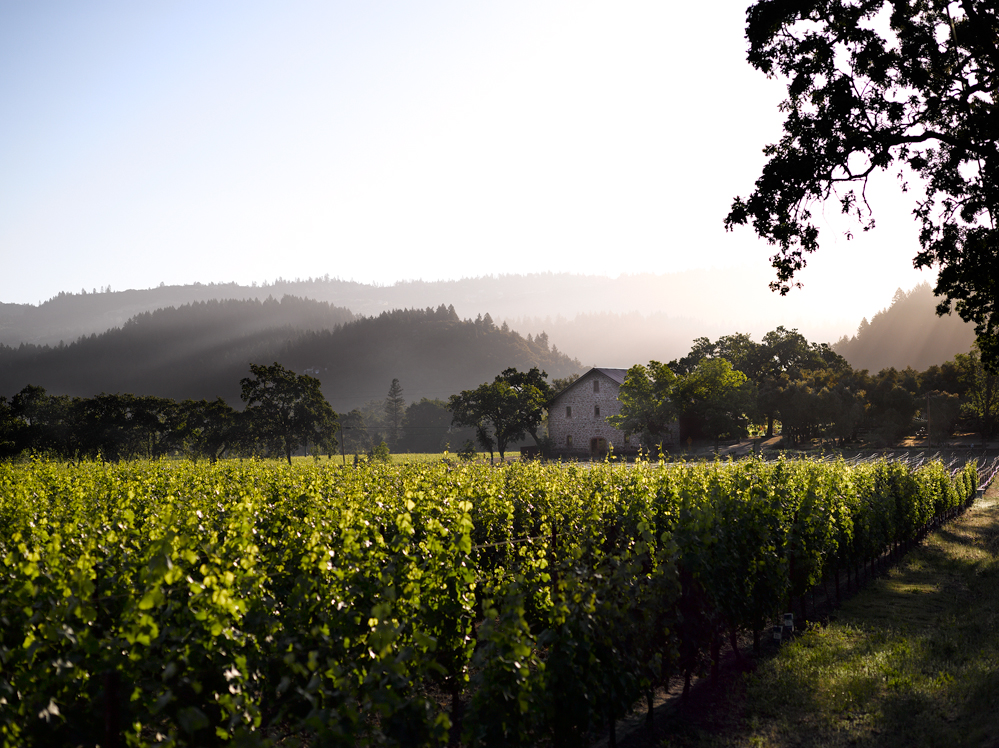 The estate, located in
St. Helena in the Napa Valley, comprises 42
acres planted with Bordeaux varietals. Founded
in 1885 by Bernard Ehlers, it is now owned by
the Leducq Foundation, a trust established by
Jean and Sylviane Leducq (above with
Morrisey) in 1996. The
two French entrepreneurs and philanthropists saw
potential to make Bordeaux-style wines at the
Ehler estate, releasing their first vintages in
2000. Small
production and allowing the wines the time to
mature were as important as turning a profit,
even if that meant making wines that ran counter
to the market-driven Napa Valley wine industry,
where bigger wines so often win awards as better
wines.
The estate, located in
St. Helena in the Napa Valley, comprises 42
acres planted with Bordeaux varietals. Founded
in 1885 by Bernard Ehlers, it is now owned by
the Leducq Foundation, a trust established by
Jean and Sylviane Leducq (above with
Morrisey) in 1996. The
two French entrepreneurs and philanthropists saw
potential to make Bordeaux-style wines at the
Ehler estate, releasing their first vintages in
2000. Small
production and allowing the wines the time to
mature were as important as turning a profit,
even if that meant making wines that ran counter
to the market-driven Napa Valley wine industry,
where bigger wines so often win awards as better
wines.
The vineyard is divided
into five main blocks, based primarily on soil
type, and 25 sub-blocks, with six different
clones of cabernet sauvignon planted on multiple
rootstocks, seven sub-blocks of Merlot, four of
cabernet franc, two of sauvignon blanc and a
block of petit verdot. The vineyard’s
microclimate has mornings cooled by fog, full
sun at midday, and, as the afternoon progresses,
they are cooled down by valley breezes.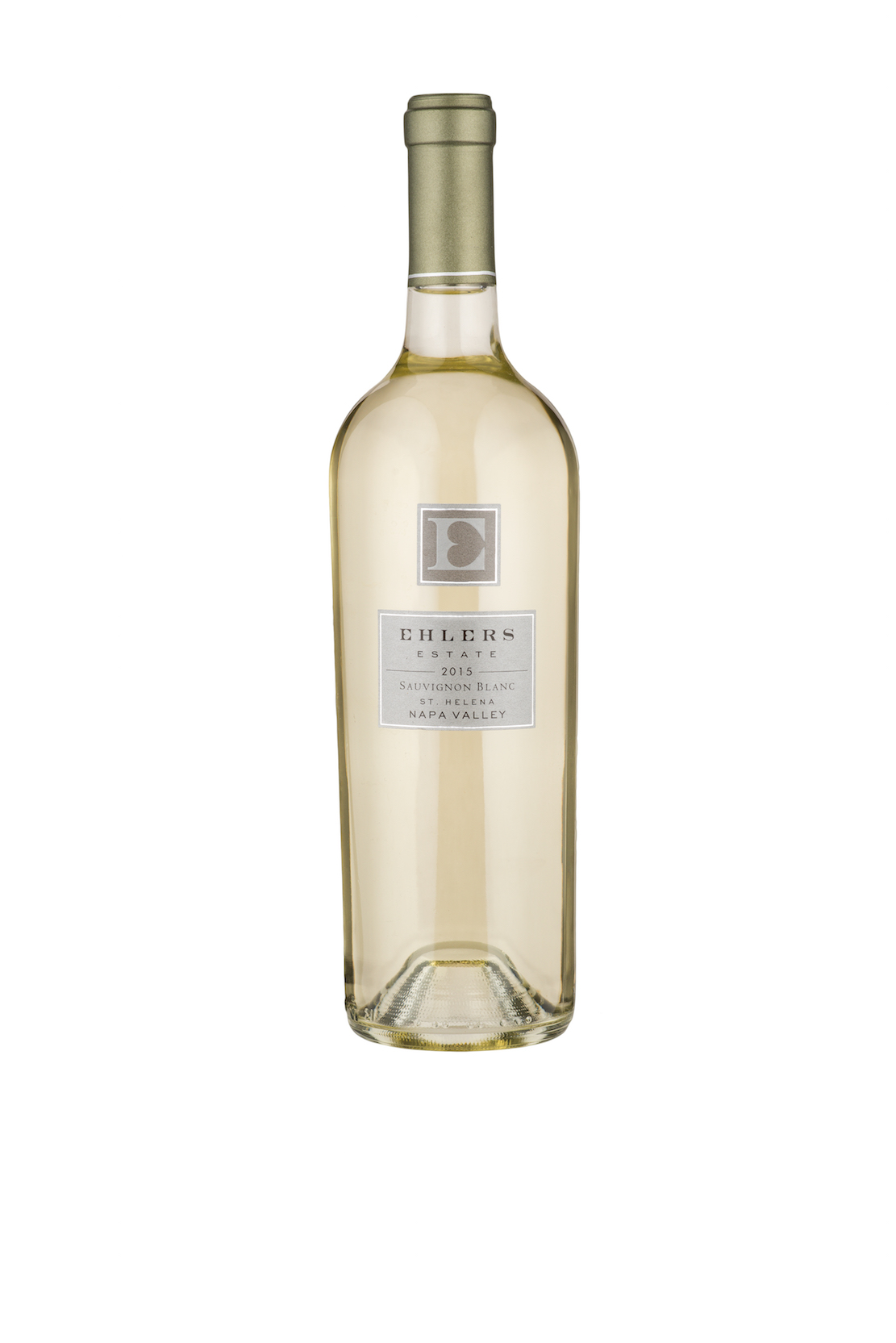
Ehlers Estate makes seven
wines, several of which we tasted during our
dinner at CUT steakhouse, including that superb
Sauvignon Blanc 2015 ($28), which does indeed
remind me of some of the finest Sancerre, like
Domaine Gérard Filou’s Sancerre Blanc “Silex.” Fruit
and acid are here in perfect equilibrium, crisp,
more floral than grassy.
This was followed by a
charming 2013 Merlot,
with 5% cabernet franc ($55), whose velvety
smoothness and layered structure shows just how
well Morrisey learned his lessons at Château
Pétrus, not least how well such a wine will
mature over the next decade. The 2013 Cabernet
Franc ($60) was his way of proving this
second-tier varietal has its own dimension and
virtues. The
2013 vintage of the “1886” Cabernet Sauvignon
($110)—the “1886” commemorates the estate’s
first vintage—is a typical Bordeaux blend of 85%
cabernet sauvignon, 8% cabernet franc, 5%
merlot, and 2% petit verdot, and, at 14.2%
alcohol, is proof that California need not
produce high alcohol red wines that give little
indication that they can age well. Ehlers’
cabernet sauvignon is now tightly knit and the
tannins need to release their grip to allow the
merlot to soften the wine, while the franc and
the petit verdot will add fruit and spice.
After
meeting Morrisey and listening to how he is
happiest when working hardest in that private
room of his, the music pumping in the
background, I can imagine him singing along with
Lynyrd Skynyrd, “Ain't
no cell phone towers, you won't catch me
online./Workin' with my hands for hours, is how
I spend my time./And I don't stand in line for
coffee, It ain't my cup of tea./Out here in the
country we got everything we need.”
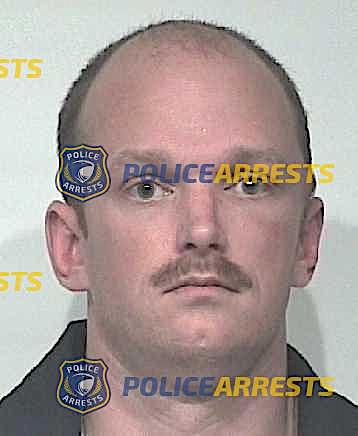 YO, STUFF LIKE
THIS HAPPENS IN
YO, STUFF LIKE
THIS HAPPENS IN
ROCKAWAY BEACH ALL THE TIME
In Rockaway Beach, NY, Whitney Aycock (left), nicknamed the" Pizza Nazi," was arrested in December, for allegedly cutting a hole in the wall of his former restaurant, Whit’s End, and absconding with its oven, although it belonged to the new tenant, the Playland Motel home. Mr. Aycock contended he was "helping a friend" by cutting the hole, then using a forklift to load the $15,000 Stefano Ferrara oven onto a flatbed truck. He was charged with criminal mischief.
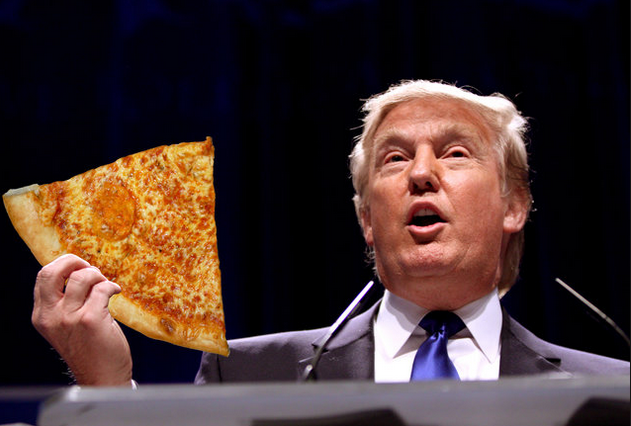
"2017 Is the Year of the Square Pizza"
by Robin
Raisfeld and Rob
Patronite,
NY Magazine
(1/10/17).
Any of John Mariani's books below may be ordered from amazon.com.
 The
Hound in Heaven (21st Century Lion Books)
is a novella, and for anyone who loves dogs,
Christmas, romance, inspiration, even the supernatural, I
hope you'll find this to be a treasured favorite.
The story concerns how, after a New England teacher,
his wife and their two daughters adopt a stray puppy found
in their barn in northern Maine, their lives seem full of
promise. But when tragedy strikes, their wonderful dog
Lazarus and the spirit of Christmas are the only things
that may bring his master back from the edge of
despair.
The
Hound in Heaven (21st Century Lion Books)
is a novella, and for anyone who loves dogs,
Christmas, romance, inspiration, even the supernatural, I
hope you'll find this to be a treasured favorite.
The story concerns how, after a New England teacher,
his wife and their two daughters adopt a stray puppy found
in their barn in northern Maine, their lives seem full of
promise. But when tragedy strikes, their wonderful dog
Lazarus and the spirit of Christmas are the only things
that may bring his master back from the edge of
despair. WATCH THE VIDEO!
“What a huge surprise turn this story took! I was completely stunned! I truly enjoyed this book and its message.” – Actress Ali MacGraw
“He had me at Page One. The amount of heart, human insight, soul searching, and deft literary strength that John Mariani pours into this airtight novella is vertigo-inducing. Perhaps ‘wow’ would be the best comment.” – James Dalessandro, author of Bohemian Heart and 1906.
“John Mariani’s Hound in Heaven starts with a well-painted portrayal of an American family, along with the requisite dog. A surprise event flips the action of the novel and captures us for a voyage leading to a hopeful and heart-warming message. A page turning, one sitting read, it’s the perfect antidote for the winter and promotion of holiday celebration.” – Ann Pearlman, author of The Christmas Cookie Club and A Gift for my Sister.
“John Mariani’s concise, achingly beautiful novella pulls a literary rabbit out of a hat – a mash-up of the cosmic and the intimate, the tragic and the heart-warming – a Christmas tale for all ages, and all faiths. Read it to your children, read it to yourself… but read it. Early and often. Highly recommended.” – Jay Bonansinga, New York Times bestselling author of Pinkerton’s War, The Sinking of The Eastland, and The Walking Dead: The Road To Woodbury.
“Amazing things happen when you open your heart to an animal. The Hound in Heaven delivers a powerful story of healing that is forged in the spiritual relationship between a man and his best friend. The book brings a message of hope that can enrich our images of family, love, and loss.” – Dr. Barbara Royal, author of The Royal Treatment.
 |
The Encyclopedia of American Food and Drink by John F. Mariani (Bloomsbury USA, $35) Modesty forbids me to praise my own new book, but let me proudly say that it is an extensive revision of the 4th edition that appeared more than a decade ago, before locavores, molecular cuisine, modernist cuisine, the Food Network and so much more, now included. Word origins have been completely updated, as have per capita consumption and production stats. Most important, for the first time since publication in the 1980s, the book includes more than 100 biographies of Americans who have changed the way we cook, eat and drink -- from Fannie Farmer and Julia Child to Robert Mondavi and Thomas Keller. "This book is amazing! It has entries for everything from `abalone' to `zwieback,' plus more than 500 recipes for classic American dishes and drinks."--Devra First, The Boston Globe. "Much needed in any kitchen library."--Bon Appetit. |
"Eating Italian will never be the same after reading John Mariani's entertaining and savory gastronomical history of the cuisine of Italy and how it won over appetites worldwide. . . . This book is such a tasteful narrative that it will literally make you hungry for Italian food and arouse your appetite for gastronomical history."--Don Oldenburg, USA Today. "Italian
restaurants--some good, some glitzy--far
outnumber their French rivals. Many of
these establishments are zestfully described
in How Italian Food Conquered the World, an
entertaining and fact-filled chronicle by
food-and-wine correspondent John F.
Mariani."--Aram Bakshian Jr., Wall Street
Journal.
"Equal parts
history, sociology, gastronomy, and just
plain fun, How Italian Food Conquered the
World tells the captivating and delicious
story of the (let's face it) everybody's
favorite cuisine with clarity, verve and
more than one surprise."--Colman Andrews,
editorial director of The Daily
Meal.com. "A fantastic and fascinating
read, covering everything from the influence
of Venice's spice trade to the impact of
Italian immigrants in America and the
evolution of alta cucina. This book will
serve as a terrific resource to anyone
interested in the real story of Italian
food."--Mary Ann Esposito, host of PBS-TV's
Ciao
Italia. "John Mariani has written the
definitive history of how Italians won their
way into our hearts, minds, and
stomachs. It's a story of pleasure over
pomp and taste over technique."--Danny Meyer,
owner of NYC restaurants Union Square
Cafe, The Modern, and Maialino.
|
 |
 |
 |
 |
 |
 |
 |
 |
 Everett Potter's Travel Report:
Everett Potter's Travel Report: 
 Eating Las Vegas
JOHN CURTAS has been covering the Las Vegas
food and restaurant scene since 1995. He is
the co-author of EATING LAS VEGAS – The 50
Essential Restaurants (the fourth
edition of which will be published in early
2016), as well as the author of the Eating Las
Vegas web site: www.eatinglasvegas.
He can also be seen every Friday morning as
the “resident foodie” for Wake Up With the
Wagners on KSNV TV (NBC) Channel 3 in
Las Vegas.
Eating Las Vegas
JOHN CURTAS has been covering the Las Vegas
food and restaurant scene since 1995. He is
the co-author of EATING LAS VEGAS – The 50
Essential Restaurants (the fourth
edition of which will be published in early
2016), as well as the author of the Eating Las
Vegas web site: www.eatinglasvegas.
He can also be seen every Friday morning as
the “resident foodie” for Wake Up With the
Wagners on KSNV TV (NBC) Channel 3 in
Las Vegas.

MARIANI'S VIRTUAL GOURMET
NEWSLETTER is published weekly. Editor/Publisher: John
Mariani.
Editor: Walter Bagley. Contributing Writers: Christopher Mariani,
Robert Mariani, Misha Mariani, John A. Curtas, Geoff Kalish, Mort
Hochstein, and
Brian Freedman. Contributing Photographers: Galina
Dargery. Technical Advisor: Gerry McLoughlin.
To un-subscribe from this newsletter,click here.
© copyright John Mariani 2017

